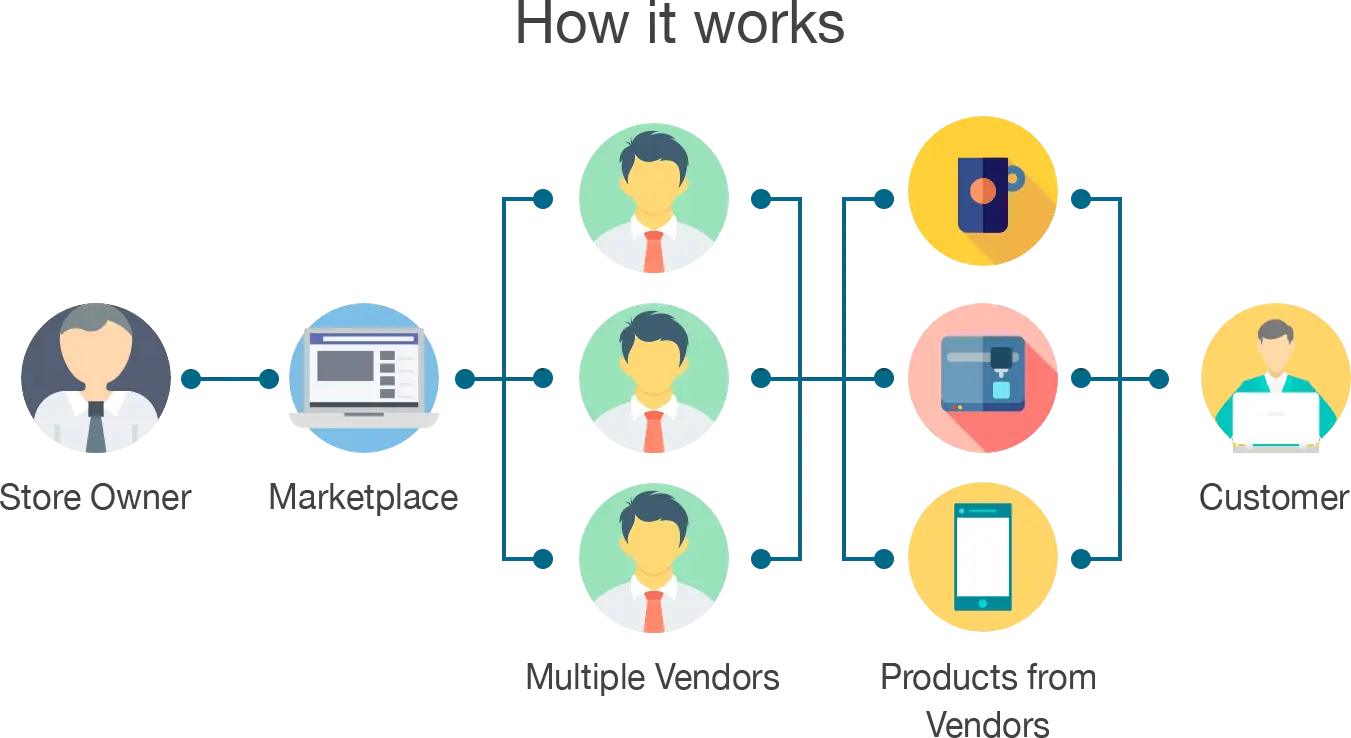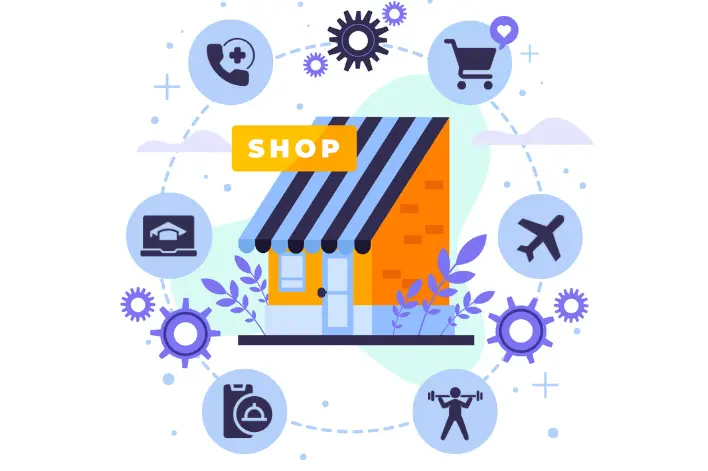According to Forbes, Nykaa’s revenue collections in the Indian online marketplace increased from just over INR 5 billion to INR 51 billion in fiscal year 2023.
Several reasons have propelled the booming growth of online marketplaces in recent years.
Firstly, the continuous rise in internet penetration and smartphone usage worldwide has made online shopping more accessible.
Secondly, the convenience and variety offered by online marketplaces have attracted a growing number of consumers. Shoppers can browse various products from different sellers, compare prices, read reviews, and purchase from the comfort of their homes.
Thirdly, Faster delivery times and efficient return policies have made online shopping more appealing, increasing consumer trust and repeat purchases.
E-commerce has witnessed a notable surge in popularity not only in metro cities or tier-1 urban centres but also in tier-2 cities and smaller towns. An impressive 60% of online orders now originate from these regions, highlighting a significant shift in consumer behaviour and market dynamics.
What is the Marketplace Model?
The marketplace model is a business framework where a platform serves as an intermediary connecting buyers and sellers, facilitating transactions without owning the products or services sold.
This model allows a centralized venue where sellers can list their offerings and buyers can discover, compare, and purchase items.
Marketplaces model may generate revenue through various means such as transaction fees, subscription plans, advertising or commission revenue model.
By leveraging network effects and scalability, successful marketplaces create dynamic ecosystems that foster growth, enhance consumer choice, and drive continuous innovation in digital commerce.
Why Starting Your Own Marketplace Rocks as an Option in 2024?
Uber, the world's largest taxi company, owns no vehicles. Facebook, the world's most popular media owner, creates no content. Alibaba, the most valuable retailer, has no inventory. And Airbnb, the world's largest accommodation provider, owns no real estate. Something interesting is happening. - Tom Goodwin
Still, if you're not convinced, here are more reasons why a marketplace can be a powerful revenue engine. Starting your marketplace in 2024 can be a desirable option for several compelling reasons:
1. Market Opportunity and Growth Potential
The e-commerce sector continues to experience robust growth, with online shopping becoming increasingly ingrained in consumer habits worldwide.
Starting your marketplace allows you to tap into this expanding market and capture a significant share.
As more consumers and businesses embrace online shopping, there's ample opportunity to carve out a niche or cater to specific segments that existing platforms may underserve.
2. Diversification and Flexibility
Operating your marketplace provides flexibility regarding product offerings and business models. Unlike traditional retail or single-brand e-commerce sites, marketplaces can host a wide range of products from multiple sellers.
This diversification attracts a broader customer base and reduces dependency on any single product line or supplier.
Additionally, you can adapt and scale your marketplace according to market trends and consumer demands, offering new categories or adjusting commission structures as needed.

3. Low Overhead and Scalability
Launching a digital marketplace typically requires lower initial investment and overhead costs than establishing a physical retail presence.
Cloud-based infrastructure, scalable software solutions, and third-party service providers for logistics and payment processing make launching and operating an online marketplace easier and more cost-effective.
As your platform gains traction and scales, you can invest in expanding features, improving user experience, and marketing efforts to drive further growth.
4. Revenue Streams and Monetization
Marketplaces offer multiple revenue streams beyond direct product sales. These include listing fees, transaction fees, subscription models for premium services, advertising placements, and partnerships with third-party service providers.
Diversifying your revenue sources can help stabilize income and optimize profitability over time. Moreover, leveraging data insights from your marketplace can enable targeted marketing initiatives and personalized customer experiences, unlocking additional revenue potential.
Before You Start Your Own Online Marketplace
You've done your research and have made up your mind to launch your own marketplace. But before you begin, there are two things you must decide beforehand. This will affect the success factor of your marketplace app or website.
1. Research Target Audience
Before moving ahead with an online marketplace idea, carefully outline your target audience. Ask questions from real users if they want such a marketplace. Go to internet forums to check the demand.
If possible, conduct a live survey online. You don't need money to research. You just need to have a plan. Here is a great way to get started with researching and documenting your audience.
This step will give you an insight into how to choose the perfect online marketplace model users would love using right away.
2. Choose the Right Online Marketplace Business Model
Once you know what users want, you can choose from one of the popular online marketplace models - freemium, subscription, listing, ad-based, or commission-based. You can also think of something completely different in case real users want that.
The best thing in this case would be that you will be building around user expectations and not the other way around.
Steps to Develop Your Online Marketplace
Okay, now we've set a solid foundation, let's move on to building a structure. Right?
You'll need to have a clear direction for transforming your dream into a reality. Developing an online marketplace involves several vital steps to ensure a successful launch and sustained growth. Here’s a structured approach:
1. Market Research and Planning
Identify Your Niche: Research and identify a niche market or industry segment where there's demand and potential for growth.
Competitor Analysis: Analyze existing marketplaces and competitors to understand their strengths, weaknesses, and gaps.
Define Unique Value Proposition: Determine what sets your marketplace apart—unique features, better user experience, or a specific target audience.
2. Business Model and Monetization Strategy
Choose a Business Model: Decide on the type of marketplace model—such as B2B, B2C, hybrid, or C2C marketplace model—that best fits your target market and goals.
Revenue Streams: Define your monetization strategy, whether through transaction fees, subscription plans, advertising, or other revenue models.
3. Legal and Regulatory Considerations
Business Structure: Choose a legal structure for your marketplace (e.g., LLC, corporation) and register your business.
Compliance: Ensure compliance with local regulations, including data protection laws, tax requirements, and industry-specific regulations.
4. Platform Development
Technology Stack: Select a suitable technology stack based on your marketplace requirements, scalability needs, and budget.
Features and Functionality: Develop essential features such as user registration, product listing, search and filter options, secure payment gateway integration, messaging systems, and feedback/review mechanisms.
User Experience (UX) Design: Create an intuitive and seamless user interface (UI) that enhances user experience and encourages engagement.
5. Supplier and Vendor Onboarding
Acquire Sellers: Attract and onboard sellers/vendors to populate your marketplace with products or services.
Clear Guidelines: Establish guidelines, policies, and standards for seller s/v endors regarding product/service listings, pricing, shipping, and customer service.
6. Launch and Marketing
Soft Launch: Conduct a soft launch or beta testing phase to gather feedback and identify areas for improvement.
Marketing Strategy: Develop a comprehensive marketing plan to attract buyers and sellers to your marketplace. Utilize digital marketing, social media, SEO, content marketing, and possibly influencer partnerships to build awareness and drive traffic.
7. Customer Support and Community Building
Customer Support: Implement robust customer support mechanisms to promptly address inquiries, issues, and disputes.
Community Engagement: Foster a community around your marketplace through forums, blogs, and social media to encourage user interaction and loyalty.
8. Analytics and Iteration
Analytics: Implement tools to track key metrics such as traffic, user behaviour, conversion rates, and sales performance.
Continuous Improvement: Gather and analyze data to iterate and improve your marketplace based on user feedback and market trends.
9. Scaling and Expansion
Scalability Plan: Plan for scalability from the outset to accommodate user growth, transactions, and marketplace operations.
Expansion Strategy: Explore opportunities for geographic expansion, introducing new product categories, or enhancing existing features to attract a broader audience.
10. Monitoring and Maintenance
Regular Maintenance: Regularly update and maintain your marketplace platform to ensure security, performance, and functionality.
Monitor Trends: Stay updated on industry trends, consumer preferences, and technological advancements to adapt your marketplace strategy accordingly.
Must-have App Features for a Marketplace Startup
You'll have to carefully plan for the features you need, keeping all the aspects in mind.
Miss on something here and you will be missing out on your growth story. It's not that one can't update later, but the best marketplaces start with at least the basic functionality.
It is better to develop an MVP for your marketplace business first with basic features and evolve on-the-go. Here are some features, you should consider for your marketplace MVP.
Marketplace Business Models: How Do Marketplaces Earn Money?
Let’s admit it: we are all here for the money. No one can change the world without money in their pocket. So, while marketplaces are improving lives and simplifying shopping experience, it is important to understand they’re also growing their revenues.
Now, if you’re thinking of developing and launching your own marketplace, you need to understand the marketplace revenue models that are working in 2024.

A marketplace business earns revenues using either of the following ways:
Commission Model Marketplaces: Sellers pay a commission for each sale on the marketplace platform.
Subscription Model Marketplaces: They charge a fixed subscription amount from sellers to come on board.
Freemium Model Marketplaces: Some features are free and for more, the sellers or buyers have to pay money. Digital asset websites like Unsplash work on a similar model.
Listing Focused Marketplaces: The marketplace asks for money for a product/service listing on the platform.
Featured Ads/Promotions-based Marketplaces: The marketplace charges for promotions and advertisements on the platform from the sellers.
Popular Examples of 7 Online Marketplace Business Models
1. B2C (Business-to-Consumer): In this model, businesses sell products or services directly to consumers.

- Example: Amazon.com allows businesses to sell directly to individual consumers across various product categories.
2. C2C (Consumer-to-Consumer): Consumers sell products or services directly to other consumers through a platform.

- Example: eBay enables individuals to list items for sale to other individuals, creating a peer-to-peer marketplace.
3. B2B (Business-to-Business): Businesses sell products or services to other businesses through an online marketplace.

- Example: Alibaba.com connects businesses worldwide, facilitating bulk purchases and trade transactions.
4. P2P (Peer-to-Peer): Platforms facilitate the sharing or rental of goods and services between individuals.

- Example: Airbnb allows individuals to rent their properties or spare rooms to others seeking short-term accommodations.
5. Freelance or Gig Economy: Platforms connect freelancers or independent contractors with businesses or clients seeking specific services.

- Example: Upwork offers a marketplace where freelancers can offer services ranging from writing and design to programming and consulting.
6. Vertical or Niche Marketplaces: These platforms focus on specific industries or verticals, catering to specialized needs.

- Example: Houzz specializes in home improvement and interior design products and services, connecting homeowners with professionals and vendors.
7. Subscription-based Marketplaces: Users pay a recurring fee to access exclusive products, services, or content within the marketplace.

- Example: Patreon allows creators to offer their supporters subscription-based access to exclusive content or experiences.
Tips to Improve Product Management in Marketplace
Allow sellers to add products in bulk or provide onboarding service.
Offer a way to integrate existing online catalogs to your marketplace.
Optimize your product listing forms and make everything in ‘Ready to Publish' mode.
1. Managing Payments
"If you can make them trust you with their money, there's nothing that will stop your growth."
Customers and vendors would need a secure payment gateway when they use your marketplace. Also, as you'll be a marketplace, your payment gateway should allow customers to pay for products/services from multiple sellers at once in a single checkout.
Choosing and managing the payment gateway will be your biggest decision that will determine the user's shopping experience.
While choosing a gateway, just keep in mind that it should cater to your multiple requirements:
Allow sellers to pay subscription fee (in case you're on a subscription model)
Streamline customer payments for products from multiple vendors
Automated seller payouts from your platform to their accounts
Your payment flow would lead you to a specialized marketplace payment gateway.
If you can't find any, you will have to take the long route to create a system that can handle invoicing, taxation, payment charges, reporting, reconciliation and a lot more. In such a case a marketplace development expert would come in handy.

2. Order & Shipping Management
"You don't leave the engines dry when the ship runs because of them."
Though order fulfillment won't be your concern if you are not managing inventory, but you'll need to give your sellers the tools to assist with order management.
If you want, you can take care of fulfillment just like Amazon FBA, but if you want sellers to be responsible, you'll have to get proactive.
The sellers should find your platform easy to manage in terms of communication, delivery updates, shipping rules and more. Also, there should be a high level of customization and integration with shipping providers from the start.
Also, when someone orders from your platform, he/she will expect updates on their order. So, you will have to sort things like:
Order tracking management
Third-party APIs for shipping service providers
Creating SLAs for standard shipping rules across your marketplace
Setting a minimum/maximum standard for shipping costs and speed
Upfront shipping date intimation and staying on schedule would affect your conversion rate and ultimately success. So, you really need to make this work for your sellers and your marketplace.
3. Customer Management
"When you treat them with care and respect, they would bring their friends, relatives and acquaintances to make them feel the same."
If sellers are your engine, customers are the fuel that runs those engines. So, you really need to be careful about how you manage the customers on the platform.
For the starters, they should feel secure for signing up on the platform and giving you their payment details, address and other personal information. Secondly, your interface shouldn't challenge them but assist them in their shopping journey.
Personalized product feed, filters, a dedicated profile for them to track their orders, addresses, past purchases, etc. would help them engage with the marketplace.
At the backend, you should have a robust system to manage customer profiles. Also, their preferences should be secured in a secure way for everything you want them to feel for your marketplace brand.
How Much Will it Cost to Develop a Marketplace App in 2024?
We've come a long way - from discussing the idea to talking of the launch. But you have the one question that overshadows everything. What would it cost you to launch your own marketplace? Right?
Well, as you see, it is a lot of work to create a successful marketplace in 2024. And you can't think of doing all that with just a one-person army or a small team.
You would need analysts, product managers, developers, UI/UX designers, testers, marketing experts and more to make your show a hit. Engaging everyone would cost money too.
That's why we said it's better to hire remote teams instead of building every capability in-house.
Remote teams charge by the hour, based on their location and you can easily find a team that can develop your store and helps you launch it within a range of USD $5,000-$20,000.
FAQs
Q: What are the types of marketplace business models?
A: The types of marketplace business models include lead fee marketplace, listing fee marketplace business, and featured listings and ads model, among others.
Q: How can I sell things online fast?
The best way is to develop an online marketplace for your niche. You can sell anything with a marketplace and even invite other sellers to grow your product base.
If you want to sell things fast, you really should think of launching your own marketplace platform because Amazon won’t let you sell fast. (Too many sellers on the platform already competing for attention)
Q: What is a lead fee marketplace?
A: A lead fee marketplace is a model where businesses pay a fee for leads or potential customers that are generated through the platform.
Q: How can I create a marketplace?
A: You can create a marketplace by using marketplace software, defining your business plan, choosing the right marketplace model, and deciding on the monetization model.
Q: What is a b2b marketplace?
A: A b2b marketplace is a business-to-business platform where companies can buy and sell goods or services to each other.
Q: What is the monetization model of an online marketplace?
A: The monetization model of an online marketplace involves generating revenue through fees, subscriptions, advertisements, or transactions on the platform.
Q: What are some examples of marketplace business models in 2024?
A: Some examples of marketplace business models in 2024 include lead fee marketplace, service marketplace, fee business model, and free and premium features model.
Q: How does a lead fee marketplace business operate?
A: A lead fee marketplace business operates as an online platform where businesses pay a fee for leads that are generated through the platform, helping them connect with potential customers.


